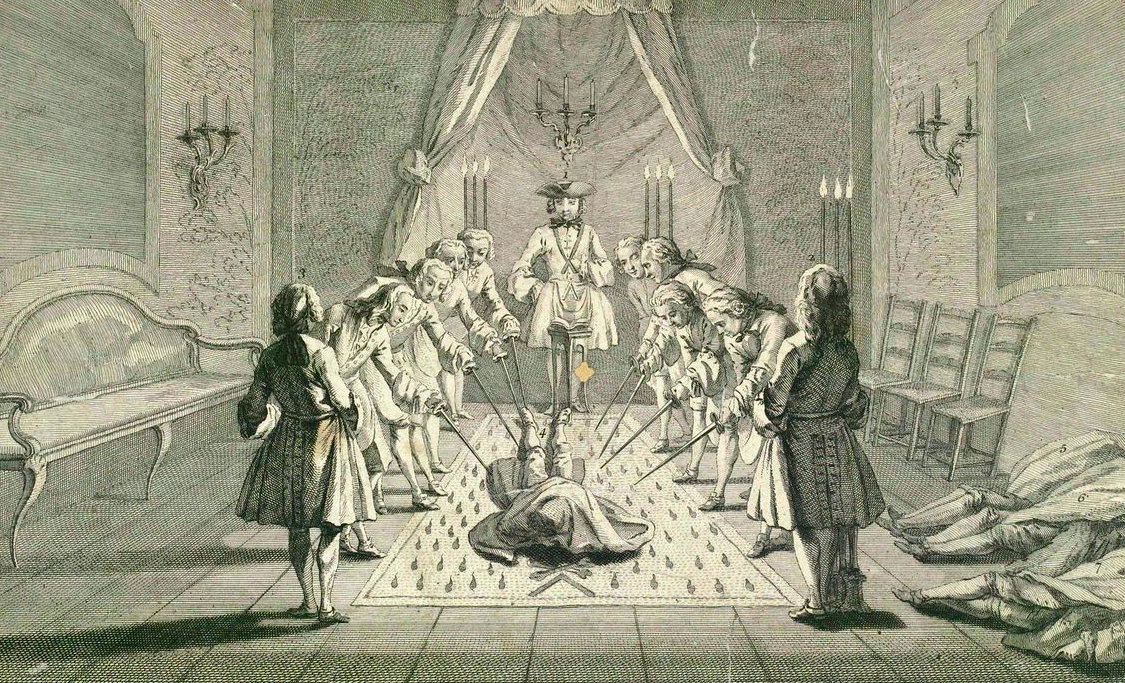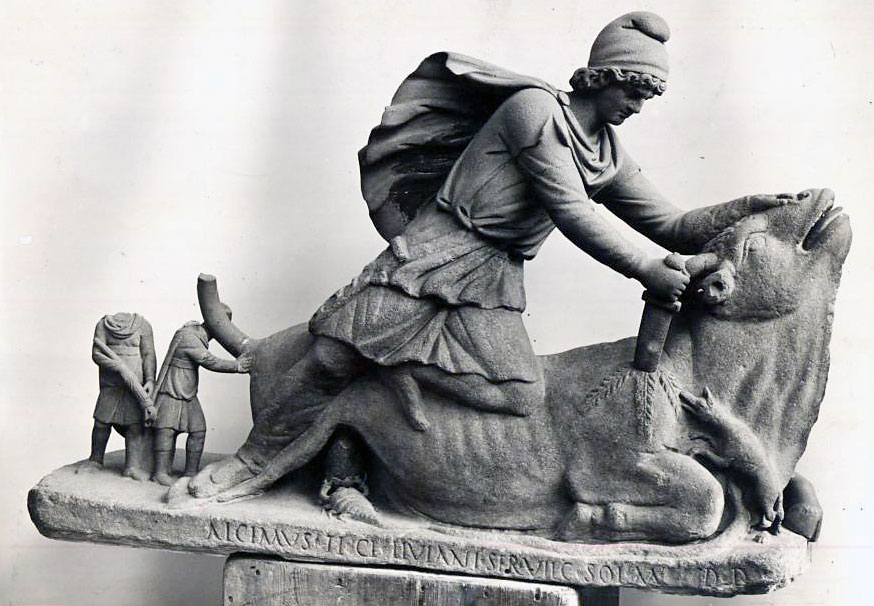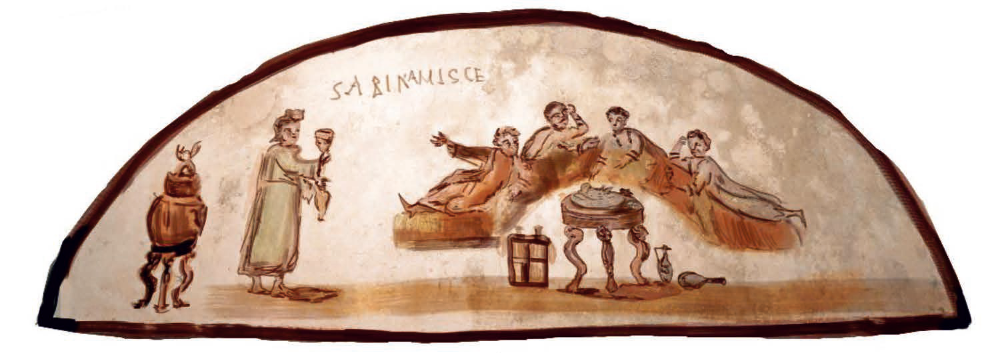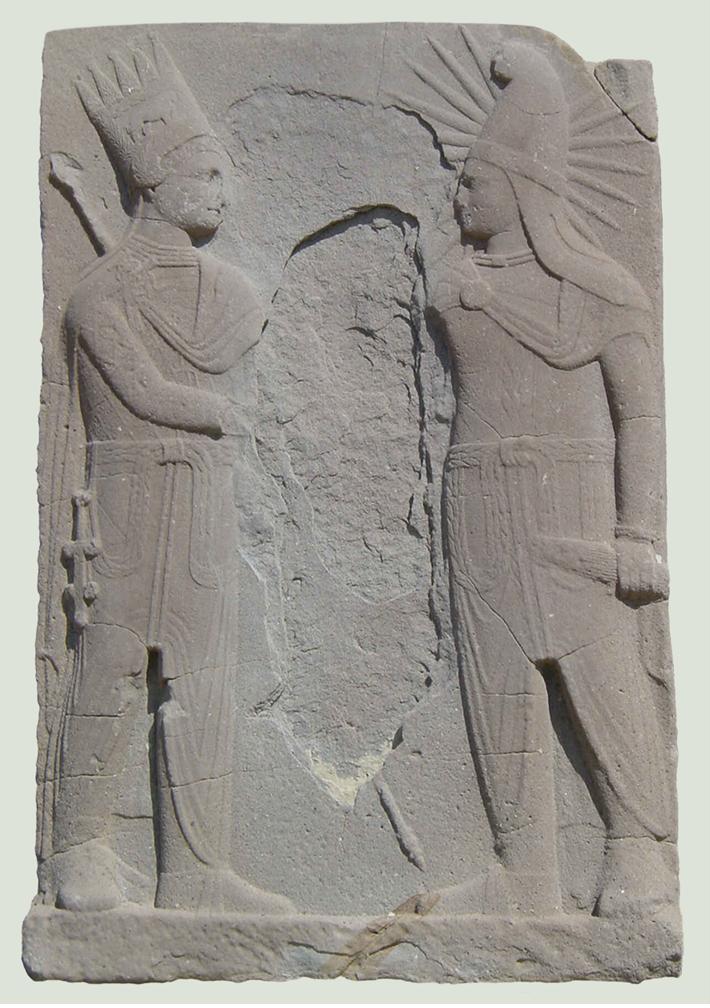From Mithraism to Freemasonry. A history of ideas

Assembly of Free Masons for the initiation of a Master
Creative Commons
The first documented mentions of the Mithraic cult in Europe, with allusions to Eastern-named gods, profuse and unmistakable iconography, and dark, subterranean temples, appear from the end of the 1st century onwards. The Thebaid of Statius is the first Latin text to name Mithras ’who twists the unruly horns beneath the rocks of a Persian cave’. We have to wait until 102 to find the first representation of Mithras sacrificing the Sacred Bull, a sculpture consecrated by Alcimus, slave of a prefect of Trajan.
As is well known, the persecution and consequent interdiction of pagan cults from the 4th century onwards put an end to the Mithraic cultic organisation as it had been known up to that time. From then on, throughout the Empire, temples would be closed, sculptures beheaded, and frescoes covered with plaster at best.
However, a good number of the initiates survived the persecution. And with them, in a more or less orthodox way, will survive the mysteries that have been revealed to them, the memory of the rituals they practised, and the knowledge they were able to accumulate. Knowledge that will continue to be transmitted sottovoce to other curious minds eager to know who was that solar god of brotherhood that their ancestors worshipped before Christianity imposed itself as the only truth in a Europe that was entering the darkness of the Middle Ages.
Knowledge is an elastic and unbreakable material
Knowledge, ideas, wisdom and culture in general are a strange matter. Like energy — perhaps that is what it is all about — ideas do not arise out of nothing and are never completely destroyed, they are simply transformed. Ideas, like gods, may change their form, even their name. They may lose some attributes, gain others, rise or fall in the hierarchy of the different schools and pantheons they inhabit, but they always end up re-emerging in one way or another when they are least expected. Perhaps this is so because ideas are as eternal as existence itself, or because they are made of the same essence as archetypes, which are the raw material from which both mythology and the most banal dreams are nourished.
Mithras, the invincible god, is a good example of the indestructibility of the values that the divinities represent. His origin is so remote that it is lost at the dawn of history. The earliest known document that mentions him beyond the borders of the Roman Empire is a 14th century BC clay tablet from Boghaz-Kay in modern-day Turkey, the ancient capital of the Hittite empire. In this document, Mithras, along with other Indo-Aryan gods, serves as the guarantor of an agreement between Hittites and Mitanni.[1]
Speculative Freemasonry arises in a particular historical and geographical context that deeply permeates each and every one of its formal aspects, while disguising its origins
In fact, the term Mithras comes from the proto-Indo-Aryan hypostasis *mitra, meaning precisely contract. In the Indian subcontinent, Mithra is considered the protector of the given word, of meetings, over which he presides, and by extension of honesty and fraternity. The same meaning for the Mithra of Iran, where his presence endures despite the reform of Zarathustra, who will try to impose a single god on the complex Mazdean pantheon.[2]
The Age of Taurus and the Year of Light
The central Mithraic myth, i.e. the sacrifice of the Celestial Bull — attended by a raven, a scorpion, a dog and a snake — which allows the regeneration of nature, has been known since ancient times as a founding act of civilisation. Mentions of a sacred bovine sent by the gods whose sacrifice is necessary to life on earth appear in texts as old as the Epic of Gilgameš, the Avesta or even the Odyssey.
The different motifs that make up the Mithraic Tauroctony coincide, in fact, with the intersection at the celestial equator of the constellation Taurus together with those of Canis Minor, Hydra, Corvus and Scorpius. This unique alignment, the so-called Age of Taurus,[3] last occurred between 4000 and 2000 B.C. This age is marked by the peak of the Sumerian civilisation, the creation of the first city states in Mesopotamia and the birth of writing. The Sumerians were among the first people to study the stars and name the constellations that, despite translations, we still recognise today.
It is therefore a pivotal period for mankind, a beginning of civilisation as we understand it today, starting in about 4000 BC, the year chosen by the Freemasons as their Anno Lucis, or year of creation.
Mithras, the god of all men
The arrival of Mithras in the Roman Empire is still a subject of debate among specialists. This archaic but civilising god, protector of friendship and agreements, appears in Western Europe in an unprecedented form. We will not find Mithras depicted so explicitly, executing the sacred Bull or sharing a meal with Sol on the skin of the sacrificed Bull, beyond the borders of the Empire.
However, the Eastern origin of the Mithraic cult in the West is attested in the initiatory hierarchy itself, which includes a degree called Persian, and in the very costume of the divinity, as well as in numerous Latin epigraphs and mentions, such as The Thebaid referred above. Despite the numerous evidences that connect Roman Mithras with homonymous Eastern gods, some contemporary theorists have proposed creationist solutions that try to distance the Western cult from that of other regions of the planet.
Be that as it may, the function of Mithras as the protector god of the given word, of contracts and of friendship will endure in the Empire and in what will remain of it, as it will in the Indo-Aryan territories as a whole. And it was precisely the value of fraternity among men, regardless of their origin, condition or status — it suffices to recall that among the initiates of the Persian cult there were emperors and slaves alike — that gave rise, in the 16th century, to the first Scottish Hermeticist lodges, the basis of what we know today as speculative Freemasonry.[4]
The temple as a reflection of the cosmos
The convergences between the mysteries of Mithras and Freemasonry do not end here. Any Master Mason interested in Mithraism will not fail to find links ranging from the most abstract to the most concrete. Many aspects of symbolic, philosophical or conceptual nature, but also material and pragmatic, such as the space in which the initiates of both schools operate.
One only has to visit a mithraeum and a Masonic temple to realise that they are one and the same thing. In both cases, it is an earthly representation of the cosmos through which souls pass in their process of reincarnation — or evolution — as Porphyry explains in his Cave of the Nymphs. A space presided over by the Sun and the Moon, and the cultic image, either the symbolic representation of the Great Architect of the Universe or that of Mithras sacrificing the Bull.
Both temples have a vaulted ceiling lined with stars. The space is windowless, closed to the outside or with strategic openings that only illuminate the sacred image at certain times of the year. The Mithraic temple, like the Masonic temple, is a timeless place where mysteries are performed, members of the community are initiated, earthly matters are deliberated, and, ultimately, brotherhood among the brethren is forged.
Both spaces are relatively small as they are adapted to communities of no more than thirty individuals. Both spaces are delimited by the four directions of a rectangular plan. On either side of a central corridor, to the north and south, the masons sit or the mithraists recline, lined up facing each other according to their degrees and qualities. In the east sits the Pater with his assistants in the one case, and the Worshipful Master and the wardens in the other.
Russell mentions in his article On Mithraism and Freemasonry that several mithraea contain shallow depressions in the floor where a sarcophagus containing the body of the symbolically deceased brother is placed. Indeed, both Masonic and Mithraic initiation, like most initiations in any tradition, are preceded by the symbolic death of the neophyte who will be reborn leaving behind his profane life. In other words, in both cases, an initiate is natus et renatus within the mystical community.
In vino veritas
One of the high moments of the Mithraic ritual is the ritual banquet. This sacrament commemorates a mythological episode that we can see depicted on many of the reliefs of the Persian cult, where Mithras and Sol celebrate their meeting with a meal on the skin of the sacrificed bull, assisted by Cautes and Cautopates. This event is part of the ritual practised by the followers of the solar god in the Mithraic temples.[5] The roles of Mithras and Sol are assumed by the Pater and Heliodromus. The whole community participates in this banquet, those of lower degree, such as the Masonic apprentices, will be responsible for assisting their brethren.
In the same way, the masons conclude their work with a banquet, in this case outside the temple, in an adjoining or outdoor room. While it is true that in the Mithraic ritual, the food eaten has a symbolic value — at least the wine and bread, which represent the flesh and blood of the Sacred Bull — all types of food are eaten at Mithraic feasts, especially poultry. Apart from the ritual element, therefore, both Mithraic and Masonic feasts are a time of relaxation where food and wine promote camaraderie.
Degrees, qualities, gestures and experiences
It is widely known that Speculative Masons are divided into three main degrees according to their seniority, experience and involvement within the community. The practice is somewhat more complex, for beyond the degrees of Apprentice, Fellow and Master, there are other symbolic or functional degrees. The same is true of the mysteries of Mithras, although, instead of three, the Mithraic initiatory ladder involves up to seven steps, to which are added higher grades with administrative roles at a supra-communal level.
In any case, to be initiated in either tradition, moral integrity is a must. It should be borne in mind that Roman Mithraism is part of the philosophical currents of the time, namely Neo-Platonism and Stoicism, to which we must add the imprint of Eastern traditions, particularly Persian, which brought the first followers to the Empire.[6] Similarly, Masonic lodges require their candidates to be men ’of good morals’ and ’without blemish of immorality’, however these values may be measured.
Another point in common between the two brotherhoods is the importance given to the gesture of shaking hands. So much so that an initiate into the mysteries of Mithras is known by the Greek term syndexios, meaning one who has exchanged the handshake.[7] It is, after all, the gesture that represents agreement and fraternity, as it was in Nemrut Dağı, Turkey, in the 1st century BC, where Antiochus shakes hands with Mithras. For their part, Freemasons use a specific variant of the handshake that allows them to recognise each other without the need to verbally express their affiliation.
It is not de rigueur to communicate the mysteries that have been revealed during an initiation, especially because the initiate undertakes not to do so — and let us remember that it is Mithras himself who is the guarantor of the promises. Neither is it worth going into detail because of the very nature of the act: the meaning of initiation lies not in a set of actions, gestures and words, but in the experience itself, in the transformative effect that the ceremony has — or does not have — on the candidate. Suffice it to mention, as a hint, Porphyry’s testimony, or that of Apuleius, to get an idea of what both Mithraic and Masonic initiation can entail.
Of course, speculative Freemasonry also has divergences from the Persian solar cult. Many of them have to do with the twelve centuries that separate them. Speculative Freemasonry arises in a particular historical and geographical context that deeply permeates each and every one of its formal aspects, while disguising its origins. Even so, Freemasonry remains to this day the greatest representative of a tradition, based on equality and fraternity, that binds its members together in a chain that stretches from the past and reaches into the future.
References
- Israel Campos Méndez (2021) El primer testimonio mitraico.
La irrupción del dios Mitra en la historia está directamente relacionada con la presencia de población indo-aria asentada entre los hurritas de Mitanni y su inclusión en un tratado de paz entre este reino y el imperio hitita a mitad del siglo XIV A.N.E. El sentido de su mención y la funcionalidad quedesempeña en el contexto del tratado parecen prefigurar las característicasque están en el origen del papel desempeñado por esta divinidad tanto en el panteón védico, como posteriormente en el iranio-zoroastriano. Mitra apareceen relación con un grupo de divinidades que definen el panteón relevantede la posterior religión védica y su vinculación con Varuna estableciendouna pareja, tendrá también su correlación con Asura en el ámbito iranio.La importancia de este texto ha sido relevante para establecer no solo laruta, sino la primera configuración de estas poblaciones indo-iranias que seestán haciendo presentes en la zona de la Alta Mesopotamia en paralelo asu introducción en el valle del Indo. Nos proponemos con esta investigación profundizar en el análisis de la información que este texto puede ofrecernosen relación con el contexto en el que se pudo gestar la primera aparición pública de Mitra, para tratar de responder más claramente a dos preguntas:quiénes fueron estos primeros individuos que dan protagonismo a esta divinidad y con qué finalidad lo hicieron. El poder conocer las características de este primer documento se convierte en un aspecto básico para establecer el punto de partida de cualquier estudio en profundidad del culto mitraico.
↑ - The New Mithraeum (2020) The origins of Mithraism, between the East and the West ↑
- David Ulansey (1991) The Origins of the Mithraic Mysteries. Cosmology & Salvation in the Ancient World ↑
- J. R. Russell (1996) On Mithraism and Freemasonry ↑
- M. Clauss (1990) The Roman cult of Mithras ↑
- Robert Turcan (1975) Mithras Platonicus ↑
- Richard Gordon (2016) Den Jungstier auf den goldenen Schultern tragen. Mythos, Ritual und jenseitsvorstellungen im Mithraskult ↑




Comments
One hypothesis is that the mythology of the Roman secret society of Mithras was transformed into an esoteric society, still secret, using the Bible as a screen. Let's take an example: a secret password for today's Masonic lodges is 'Shiboleth'. Shiboleth' means 'ears of wheat', i.e. abundance. Is not the tail of the bull of Mithras an ear of wheat? There are probably dozens of passwords like that. So Hebrew became a secret language for the followers of Mithras, who continued the cult after the fall of Rome, in sanctuaries located near springs or spas, at the same time as the cult of Hercules. Many of these places can be found in France, dating from the 7th to the 10th century. Crypts dating from the 8th and 9th centuries can also be found under Romanesque churches (the church at 'Saint Savin sur Gartempe' has a crypt dating from 800 AD, and a church built above it in 1030 AD). This crypt has a clear mithraeum shape. The modern Masonic rites were probably written in the 15th or 16th century in certain monks' chapters in France or Germany. This would explain why in the 17th century 'pro-Masonic' lodges sprang up in several different parts of Europe: Germany, Ireland, Scotland etc.... the French lodges or guilds were destroyed by Louis XV.
The modern Masonic lodge is organised around the starry vault, but the officers are still arranged in a very similar way to the Mithraeum, respecting the two solstices and the two equinoxes. The Venerable Master in the East is at the spring equinox, the first sign of the ancient Zodiac, and the seat of Mithras, from where he intervenes in the journey of souls.
Monreal monastery 12th century AD ...
Hello Gabriel,
the article you present on the relationship between the religion of the unconquered sun and 18th-century English Masonry notes the similarity of the (supposed) rituals. It is possible to draw attention to a few visual aspects:
- the followers face each other
- initiation was secret
- there are several levels of progression in the ritual
- temples are small and often private
- the temples are oriented according to the sun, and the place of the Pater (with his solar crown) is theoretically in the east (rising sun).
- In 1976, Richard Gordon showed that each Mithraic grade corresponded to a star, in particular the sun and the moon, and had a specific place in the lodge. Similarly, Masonry has retained references to the moon and the sun, and a specific place for each officer.
- Mithraism works according to the path of the souls in the rotating wheel of the Zodiac. Particularly the cycle of resurrection, Masons also venerate the 'Eternal East'. The Orthodox make the Pilgrimage of the 12 Prayers, which recalls the 12 signs of the Zodiac.
- Finally, the Masonic ritual uses a biblical esotericism with the use of many Hebrew words that have nothing to do with Judaism. The link between these two secret societies is missing. It is probably to be found in the organisation of Chapters within Catholic monasteries, reserved for monks, and secrets, whose rituals and organisation are also close to Mithraism. Mithraic symbols can also be found in medieval sculpture.
All this points to the survival of Mithraism after the 6th century in a pseudo-biblical form that had nothing to do with the religion of Moses. It would have constituted the esoteric side of Catholicism, hidden in the form of 'crypts', which, as the name suggests, were secret.
Excelente artículo Hermano. La Masonería sigue siendo la gran heredera de los antiguos misterios. Mitraístas y masones son hermanos a través del tiempo. Pensar que nuestros antepasados fueron muchos de ellos adoradores de Mitra. Saludo fraternal a todos!
Un saludo fraternal a ti, Ricardo.
Excelente su artículo que confirma la teoria del profesor Russell, del cual me basé en parte en la realización de mi artículo: https://web.archive.org/web/20190924092431/https://rrviolat.files.wordpress.com/2014/11/mitraismo-masoneria.pdf
Es evidente que la masonería introdujo elementos en sus rituales procedentes del mitraismo a lo largo del siglo XVIII y XIX conforme fueron avanzando las investigaciones sobre los hallazgos arqueológicos.
Gracias por compartir tu artículo, Roberto. Es difícil determinar en qué momento la masonería especulativa incluyó tantos aspectos de los misterios de Mitra, si fue desde el origen a través —como mencionas en tu escrito— de otras corrientes medievales que conservaron un saber más antiguo o durante su evolución en siglos posteriores, pero lo cierto es que cuesta creer que tantos paralelismos se deban al azar.
I appreciate this article as it spawned and actual (gasp!) conversation on the facebook group. Mithraists are such a secretive bunch. ;-) There were a few bits I didn't agree with, but in the main, I too feel that when Mithras could no longer command the members it once had, it simply changed its outward appearance and kept going as the Masons. A fresh coat of paint, a change of clothes, and TA DA! Easy peasy.
Pattie, you and I need to talk about those bits one of these days. I'd be glad to know more about them.
Add a comment